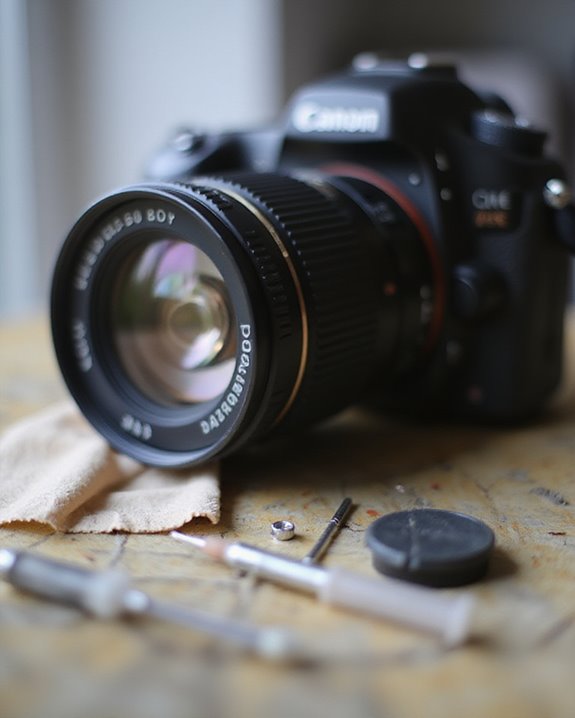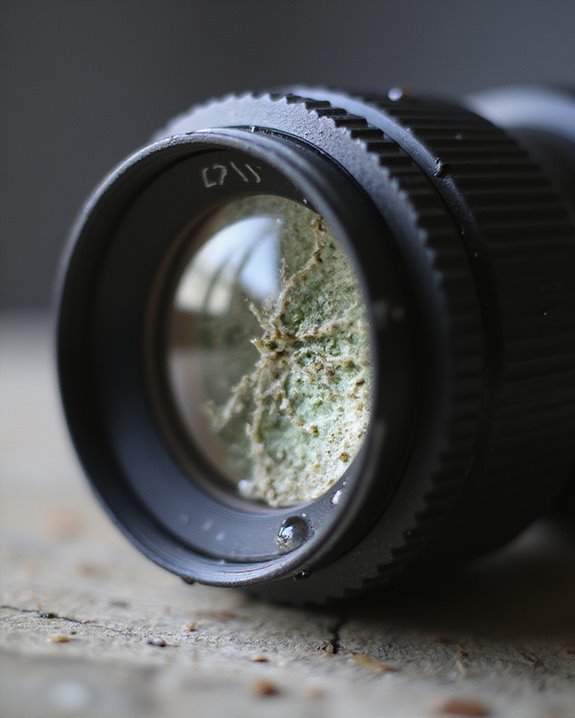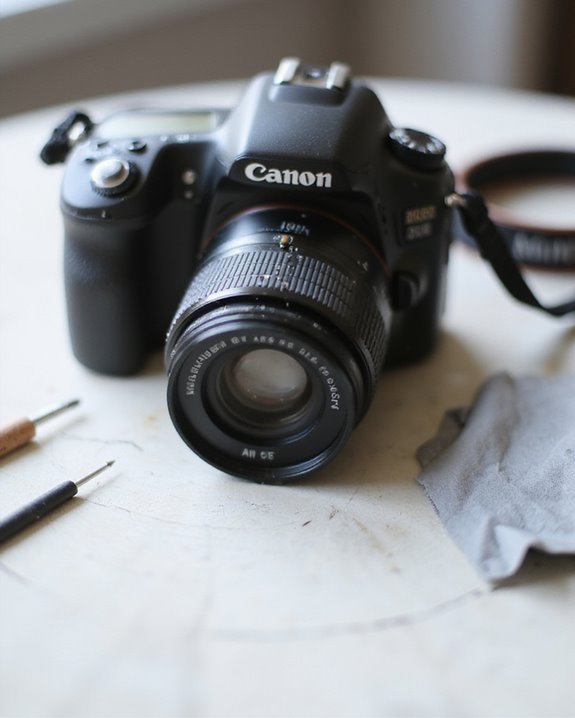To fix a stuck camera lens, first try non-invasive methods: use an air blower to remove dust, perform a hard reset by removing the battery for several minutes, or gently tap the camera to dislodge debris. For persistent issues, carefully twist the lens barrel while powering on, or try multiple power cycles with fresh batteries. Avoid applying excessive force to prevent further damage. More advanced techniques can address even stubborn mechanical lens problems.
Key Takeaways
- Use a handheld air blower to remove dust particles that could be jamming the lens mechanism.
- Remove and reinsert the battery to perform a hard reset on the camera’s electronic systems.
- Apply gentle tapping or manual twisting of the lens barrel to realign stuck components.
- Clean the lens tracks with a professional lens cleaning kit to remove accumulated contaminants.
- Try multiple power cycles with rest periods between attempts to clear electronic faults.
Understand Common Causes of Stuck Camera Lenses
A stuck camera lens can be frustrating and concerning for photographers at any skill level. Effective Cause Analysis requires understanding the five primary categories of lens failure mechanisms. Physical damage, including accidental drops and impacts, commonly disrupts internal mechanisms and misaligns critical components within the lens barrel. Contaminant accumulation, particularly sand and dust particles, can jam focus rings and extension tracks, while moisture often leaves problematic mineral deposits. Factor Identification should also include power interruptions during lens operation, which can strain motors and affect extension mechanisms. Technical malfunctions, such as gear wear and motor burnout from extended use, represent another significant category. Environmental factors, including temperature extremes and humidity, can warp plastic components and create internal condensation, respectively, leading to operational failures in lens movement systems. Additionally, the use of anti-magnetic stainless steel tools in repairs can help prevent further damage to sensitive lens components during troubleshooting.
Non-Invasive Repair Methods for Lens Jams
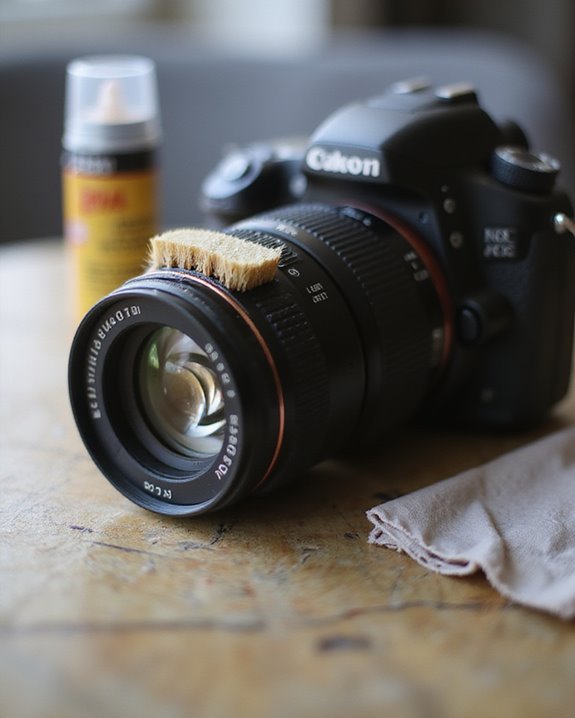
Most camera lens jams can be resolved through gentle, non-invasive techniques before resorting to disassembly. Professional photographers recommend starting with the blower technique, using a handheld air blower to dislodge any dust particles that might be causing the jam. Before mechanical manipulation, make sure the lens is clean and free from debris that could worsen the problem. Using professional cleaning kits, which include air blowers and sensor swabs, can help ensure thorough and safe cleaning to prevent further issues. Environmental factors play a significant role in lens function, making humidity adjustment an effective solution. Increasing ambient humidity may help loosen components that have become stuck due to dryness, while reducing humidity can address issues caused by expansion. If the lens remains stuck, gentle manipulation by slowly twisting or rocking the mechanism back and forth might resolve the issue. Throughout any repair attempt, patience is essential, allowing time for applied pressures to take effect.
Power-Related Troubleshooting Techniques
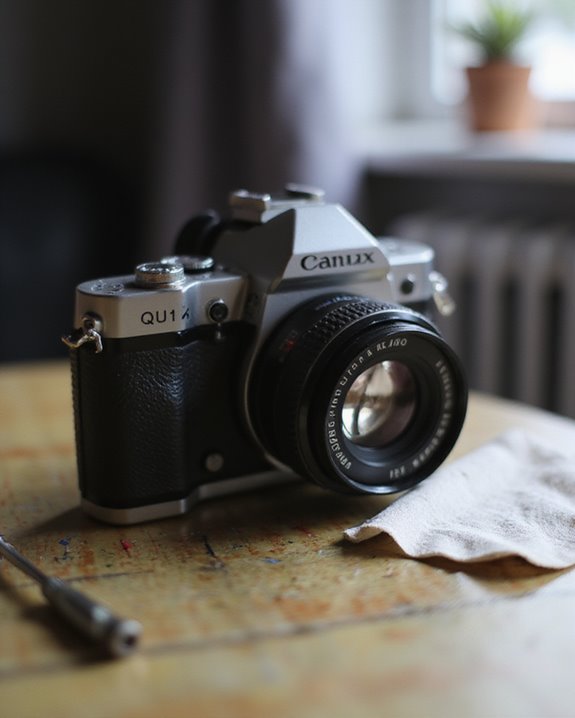
Power-related issues often underlie camera lens malfunctions, making battery management and power cycling essential troubleshooting approaches. Removing the battery for several minutes before reinsertion can trigger a hard reset, potentially resolving electronic glitches causing lens retraction problems. For best results, use high-capacity rechargeable NiMH batteries to guarantee sufficient power reaches the lens motor. Additionally, inspecting and replacing worn or damaged replacement lens components, such as those made from high-quality optical glass, can prevent recurring power or mechanical issues. Connecting an AV cable while powering on the camera redirects power from the LCD screen to the lens mechanism, providing additional AV Power to overcome mechanical resistance. This technique, when combined with simultaneously pressing the shutter and power buttons, maximizes the force available to unstick the lens. Multiple power cycles, allowing brief rest periods between attempts, can also clear persistent electronic faults that prevent normal lens operation without requiring invasive repairs.
Manual Intervention Approaches for Persistent Issues

When conventional troubleshooting methods fail to resolve a stuck camera lens, manual intervention becomes necessary to address persistent mechanical issues. Advanced Techniques like gentle tapping can dislodge debris causing lens obstruction, while careful manual twisting of the lens barrel may help realign stuck components. For best results, users should attempt these adjustments in a dust-free environment, applying minimal force to prevent further damage.
User Modifications may include grasping the inner lens barrel at its furthest extension point for cleaning, or employing a vacuum cleaner with a hose attachment to remove particles without direct contact. These interventions often require multiple attempts, systematically extending and cleaning the barrel until normal function resumes. When executed properly, these manual approaches can effectively resolve lens mechanisms that remain unresponsive to standard troubleshooting procedures.
When to Consider Professional Camera Repair
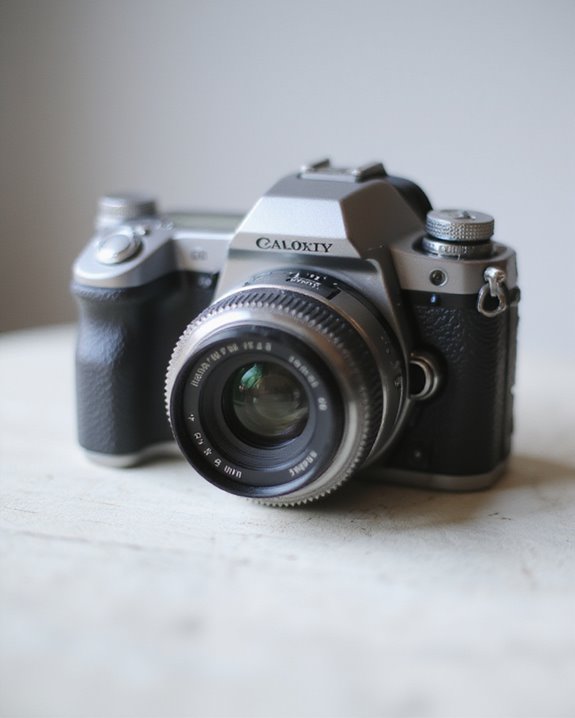
Despite diligent troubleshooting efforts, certain camera lens issues extend beyond the domain of DIY solutions, necessitating professional intervention for proper resolution. Complex problems including severe lens jams requiring complete disassembly, internal fungus contamination, impact damage causing barrel misalignment, or aperture mechanism failures typically demand specialized expertise and equipment.
A thorough Warranty Evaluation should precede any repair decision, as unauthorized DIY attempts typically void manufacturer coverage, while CPS Platinum members may qualify for complimentary maintenance services. Conducting a Cost Comparison between repair quotes and replacement options is essential, particularly when estimates exceed 50-70% of a new lens’s price. Specialized considerations apply for vintage optics with unavailable parts, saltwater exposure (which typically causes irreparable damage), and repairs requiring proprietary calibration tools for precise AF micro-adjustments or multi-coating restoration.
Frequently Asked Questions
Can a Stuck Lens Affect Camera Image Quality?
A stuck lens can greatly impact image quality. The mechanical misalignment may cause image distortion, reduced sharpness, and inconsistent focus. Internal debris or damaged elements further compromise optical performance when lens movement is impaired.
How Long Should I Wait Between Troubleshooting Attempts?
Like a patient gardener nurturing delicate seedlings, proper Waiting Periods between troubleshooting attempts should be 3-5 minutes. This Retry Timing allows internal capacitors to fully discharge and electronic components to reset completely.
Will Fixing a Stuck Lens Void My Warranty?
DIY attempts may void warranties, depending on specific warranty terms. Minimal force and gentle cleaning are generally acceptable, but professional repair is recommended to preserve warranty coverage, especially for cameras still under manufacturer protection.
Can Extreme Temperatures Cause Lens Mechanisms to Jam?
Yes, extreme temperatures can cause lens mechanisms to jam. Expanding metals, contracting plastics, and changing lubricant viscosity all contribute to Temperature Sensitivity. Expansion Effects may create misalignments that prevent smooth operation of precision components.
Are Waterproof Cameras Less Prone to Lens Jamming Issues?
Yes, waterproof cameras are generally less prone to lens jamming. Their sophisticated sealing techniques prevent debris, salt, and moisture infiltration. Waterproof advantages include specialized lubricants and corrosion-resistant components that maintain smoother lens operation over time.

